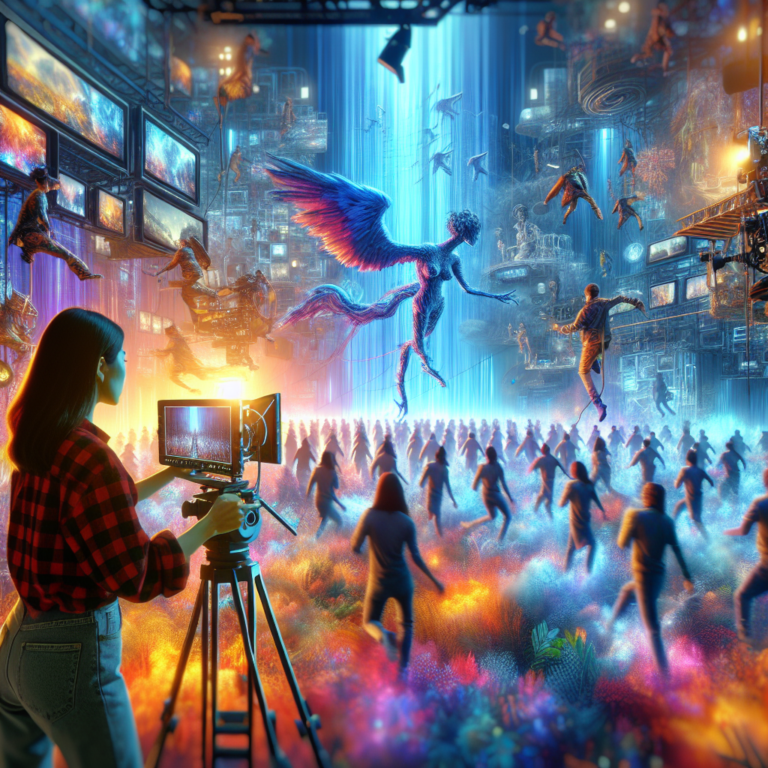The Next Frontier: How XR is Revolutionizing Cinematic Storytelling 🎥
Introduction to XR in Film Production
As we step into the future of filmmaking, one cutting-edge technology is reshaping the way stories are told and experienced: Extended Reality (XR). From Virtual Reality (VR) to Augmented Reality (AR) and Mixed Reality (MR), XR is creating immersive environments that engage audiences like never before. This blog post explores the transformative power of XR in the film industry and how it’s crafting new narratives that captivate viewers worldwide.
XR Storytelling Revolution: The Rise of XR Technology in Cinema
First, let’s unravel what XR really means. It encompasses all immersive technologies that combine the physical and digital worlds. In the realm of cinema, these technologies are not just tools; they are redefining the entire filmmaking process.
Why XR Matters in Cinematic Storytelling
- Enhanced Audience Engagement: XR offers unique storytelling possibilities that draw viewers deeper into the narrative, creating an emotional connection that traditional filmmaking often lacks.
- Creative Freedom: Filmmakers can craft narratives without the limitations of real-world settings. The sky is truly the limit with digital landscapes, characters, and environments.
- Interactive Experiences: Audiences can become part of the story, allowing them to influence the narrative and outcomes. This breaks the barrier between viewer and storyteller.
The Applications of XR in Film Production
X-ray vision body suits may not be in our immediate future, but XR is already finding its way into various stages of film production:
Pre-Production: Planning Beyond the Physical
Filmmakers are leveraging XR during the pre-production phase to conceptualize scenes and adjust elements before filming begins. Tools like AR allow directors to visualize sets, camera angles, and lighting in real-time. This not only saves time but also enhances collaboration among the crew.
Production: Immersive Filmmaking in Action
Imagine shooting a scene with an actor performing against a green screen while the background is an enchanting digital landscape. XR makes this possible, allowing filmmakers to create stunning visuals without ever leaving the studio. Here’s how:
- Virtual Sets: By using XR technologies, filmmakers can transport actors to fantastical worlds that would otherwise be impossible or costly to create.
- Real-Time Visual Effects: With the integration of real-time rendering technology, visual effects can be applied instantly, reducing lengthy post-production timelines.
Post-Production: The New Age of Editing
The post-production phase also benefits immensely from XR. Editors can work with immersive content, adjusting scenes in a 3D space, enhancing visual storytelling like never before. This capability leads to:
- Streamlined Workflows: Enhanced collaboration tools allow for efficient feedback loops between directors, editors, and visual effects teams.
- Innovative Editing Techniques: Editors can mix real footage with virtual elements seamlessly, creating a fluid visual narrative that engages audiences on multiple levels.
XR Storytelling Revolution: The Impact of XR on Storytelling
XRs influence on storytelling goes beyond the technical aspects; it reignites the creativity at the heart of cinematic art.
Challenging Traditional Narratives
With XR, filmmakers can challenge conventional storytelling methods. Data from studies shows that interactive narratives can boost memory retention and emotional engagement by allowing audiences to influence character decisions and outcomes. This participatory approach reimagines how stories are conveyed and received.
Cultivating New Genres
New genres are emerging, fully utilizing XR capabilities. Here are a few:
- Immersive Documentaries: Filmmakers create narrative-based experiences that plunge viewers into real-world events, fostering empathy and understanding.
- Interactive Films: In these pioneering experiences, viewers can make choices that determine the narrative flow, transforming traditional passive viewing into a dynamic journey.
The Future of XR and Cinematic Storytelling
As technology advances, the integration of XR into film production is expected to blossom, creating even more immersive storytelling experiences.
Expanding Accessibility
With the rise of affordable XR devices and platforms, audiences from various backgrounds will have increased access to these innovative films. This inclusivity will lead to a more diverse range of stories and perspectives in cinema.
Collaborative Storytelling
The horizon also holds promise for collaborations between filmmakers and game developers, combining expertise to craft dynamic narratives that span across multiple mediums. A fully interconnected universe will soon transcend traditional film boundaries.
Conclusion
The cinematic world is on the brink of a reawakening, powered by XR technologies that promise to transform not just how stories are told, but how they’re experienced. The convergence of creativity with technology heralds a promising future, where filmmakers harness the full potential of their imaginations to engage and inspire global audiences.




0 Comments